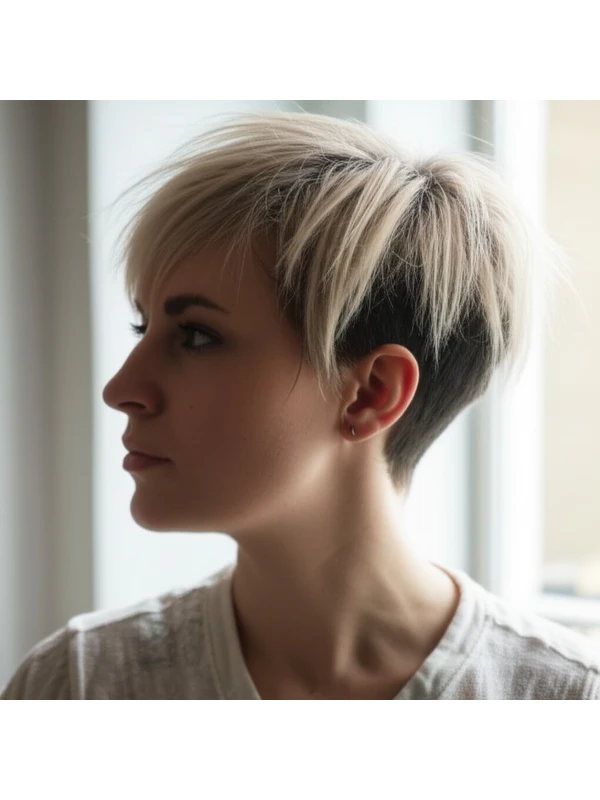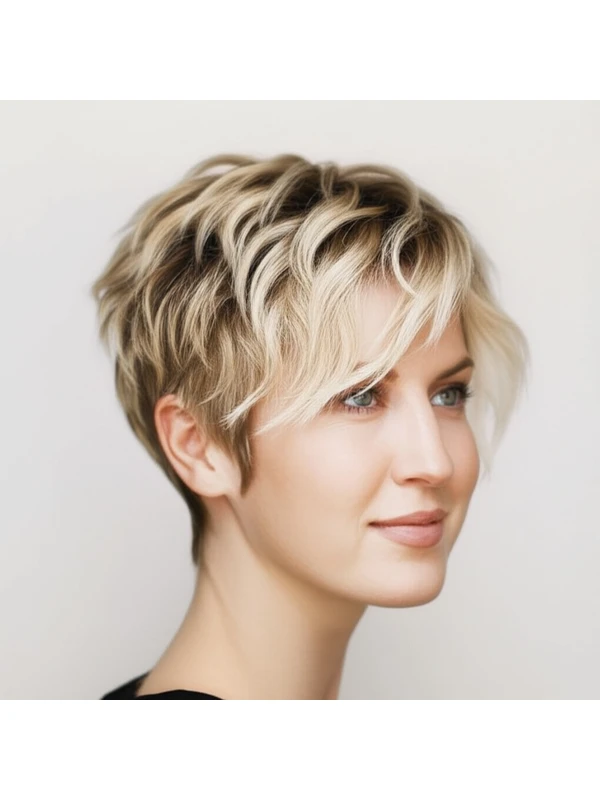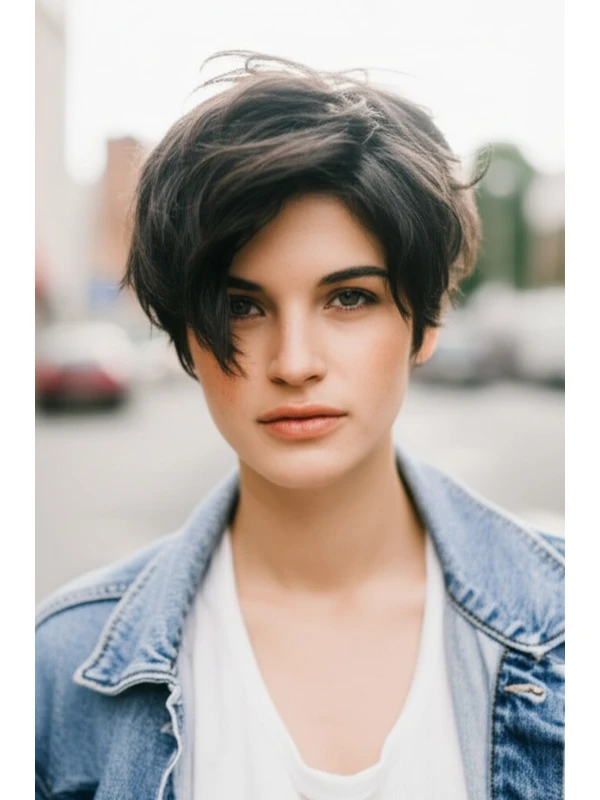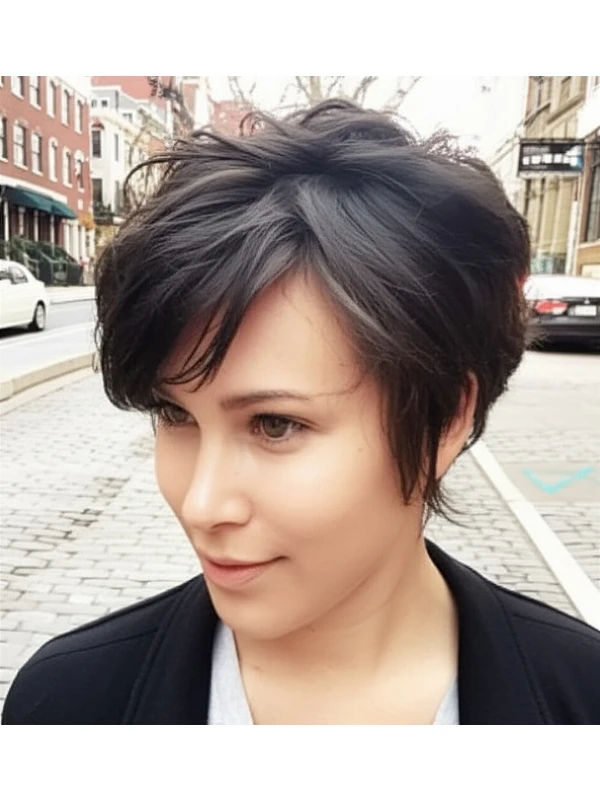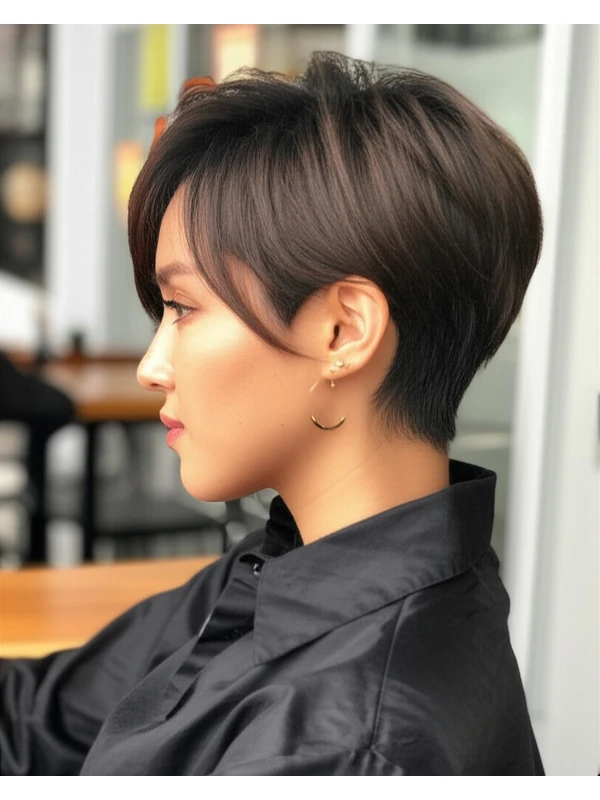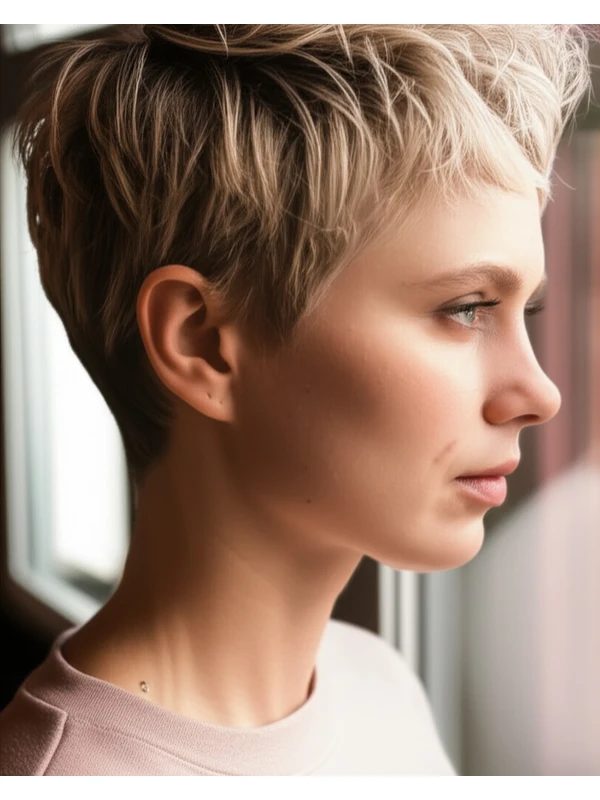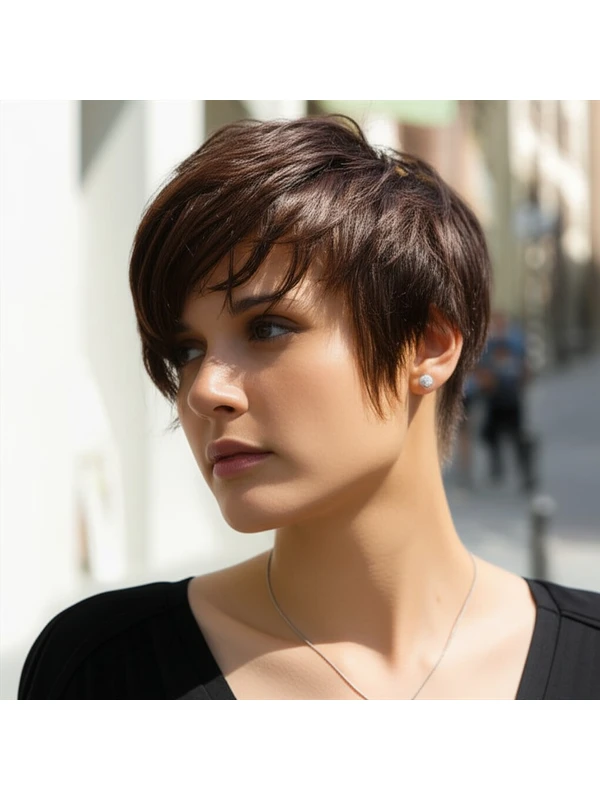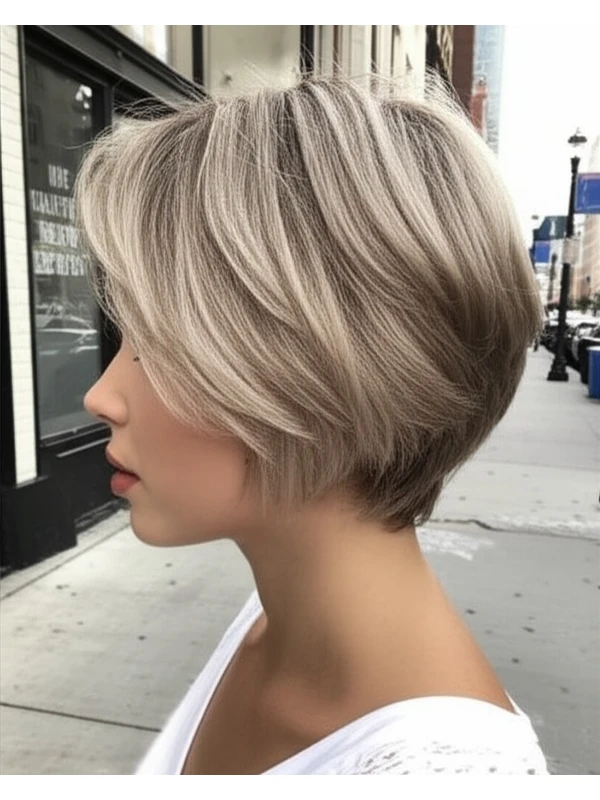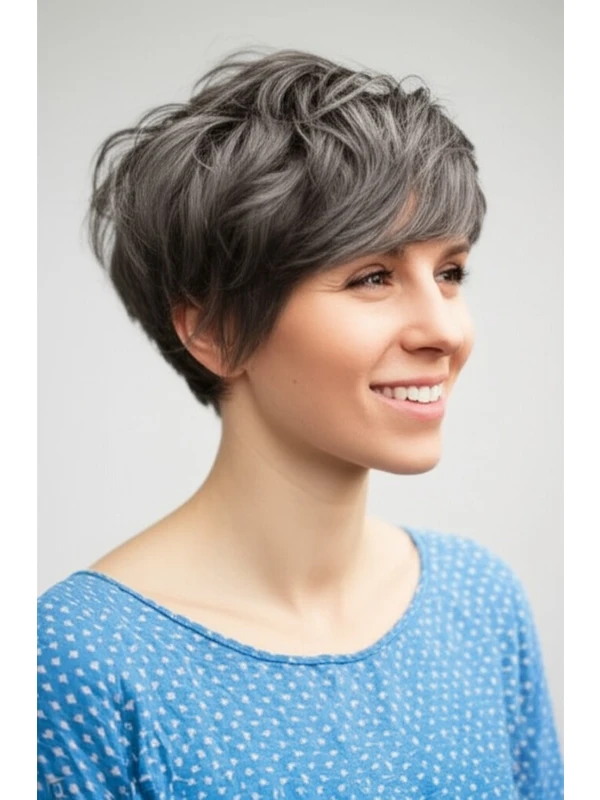#The Choppy Pixie: A Guide to Effortless Edge
The choppy pixie is a classic for a reason – it’s bold, playful, and surprisingly versatile. But getting your perfect choppy pixie requires understanding its nuances. This guide will walk you through everything you need to know, from finding the right fit for your face shape to mastering daily styling.
#1) Background & Definition: What is a Choppy Pixie?
The choppy pixie isn’t just short hair; it's about how that hair is cut and styled. Think of it as a shorter version of a layered bob, but with more deliberate disconnection and texture. The key features are:
- Disconnected Layers: This is the defining characteristic! Sections of hair are cut at varying lengths, creating visual interest and movement.
- Asymmetry: While not always extreme, asymmetry (unevenness) adds to the edgy feel – this can be in length or parting.
- Texture & Piece-iness: The “choppy” element refers to the deliberately rough edges of each layer, giving a tousled, effortless vibe.
- Length Ranges: Typically falls between ½ inch and 3 inches long at the longest point (usually on top). The nape can be shorter or longer depending on preference.
- Alternative Names: You might also hear it called an "undercut pixie," a "textured pixie," or simply a “pixie cut with layers.”
#2) Face Shape Fit: Finding Your Angle
The choppy pixie can work for many face shapes, but strategic layering and fringe are crucial.
- Oval: Lucky you! Almost any variation of the choppy pixie suits an oval face. Play with asymmetry and a longer fringe to emphasize your features.
- Round: Choppy layers add angles that soften roundness. Avoid blunt bangs; opt for side-swept or wispy fringes to elongate. Volume on top is key – avoid too much fullness at the cheeks.
- Square: Soften strong jawlines with soft, face-framing layers and a slightly off-center part. A textured fringe can also help round out angles.
- Heart: Choppy pixie draws attention away from a wider forehead. Side-swept bangs are flattering; avoid short, blunt fringes that accentuate the width of your forehead. Volume at the back adds balance.
- Diamond: The choppy pixie highlights cheekbones and softens angular features. A longer fringe can help soften the chin area.
- Oblong (Long): Create the illusion of width with layers across the entire head, especially around the sides. Avoid styles that pull hair straight back; a side-swept fringe or volume at the temples helps shorten the face visually.
#3) Body Proportions & Height Guidance: Silhouette Considerations
Your height and body shape influence how a choppy pixie looks.
- Petite: A shorter, more cropped version with minimal volume on top can prevent you from looking overwhelmed by hair.
- Average: Most variations work well; experiment with different lengths and volumes to find your ideal balance.
- Tall: You can handle a longer choppy pixie with more volume – it helps fill out the vertical space.
- Narrow Shoulders: Layers that add width at the shoulders create a more balanced silhouette. Avoid styles that are too flat or close to the head.
- Broad Shoulders: Keep the sides relatively sleek and focus volume on top to draw attention upwards, away from your shoulders.
- Short Neck: A slightly longer pixie with face-framing layers can help elongate the neck visually. Avoid styles that are too short at the back.
- Long Neck: Shorter pixies work well as they minimize the perceived length of your neck.
#4) Works Best With Hair Types & Densities: Texture Matters
The choppy pixie adapts to different hair types, but adjustments are needed.
- Straight Hair: Choppy layers show off texture beautifully! Use a texturizing product for added definition.
- Wavy Hair: The layers enhance natural waves and create effortless movement. Embrace the frizz – it adds character!
- Curly/Coily Hair: Choppy pixies can be stunning, but shrinkage is key to consider. Cut longer than your desired length to account for curl pattern. A skilled stylist who understands curly hair cutting techniques is essential. Density will impact how layers fall and the overall volume.
- Fine Hair: Layers add the illusion of thickness. Avoid too many short layers which can make fine hair look even thinner.
- Medium Hair: A classic choice! The choppy pixie works well with medium density, allowing for versatility in styling.
- Thick Hair: Choppy layers remove bulk and create a lighter feel. Thinning shears may be used to reduce weight without sacrificing volume.
Shrinkage Note (Curls/Coils): Hair can appear significantly shorter when dry than it did when wet during the cut. Always factor this in!
#5) Styling Variations: From Sleek to Tousled
The choppy pixie is a chameleon – here's how to change its look:
- Sleek vs. Textured: Use smoothing serums for a polished, sleek style or texturizing creams/sprays for a more undone vibe.
- Middle vs. Side Part: A middle part creates symmetry; a side part adds softness and asymmetry.
- Fringe Variations: Wispy bangs, blunt fringes (for bolder looks), or side-swept styles all change the overall feel.
- Occasion Styling: For work, keep it neat with a touch of product. For evenings, amp up the texture with sea salt spray and tousled waves.
#6) Maintenance: Keeping Your Pixie Sharp
- Trim Cadence: Every 4-6 weeks is typical to maintain shape and prevent overgrowth.
- At-Home Routine: Gentle shampooing (2-3 times a week), lightweight conditioner, and a leave-in product for moisture or hold.
- Heat vs. Air Dry: Minimize heat styling whenever possible to protect hair health. When using heat, always apply a heat protectant.
- Product Checklist: Shampoo/Conditioner (suited to your hair type), Leave-In Conditioner, Texturizing Cream/Paste, Finishing Spray (for hold).
- Daily Styling Time: 5-15 minutes, depending on desired style and skill level.
#7) Grow-Out Roadmap: Evolution Over Time
- Months 1-3: The shape is most defined. Regular trims are essential to maintain the choppy layers.
- Months 3-6: Layers start to blend together a bit. You can experiment with slightly longer lengths or different partings. A stylist can "soften" the edges if desired.
- Maintenance Tip: Ask your stylist to feather out any harsh lines as it grows for a more seamless transition.
#8) Color Pairings: Enhancing Your Pixie
- Cool Undertones (Pink, Blue): Icy blondes, silver, or ash brown shades complement cool skin tones and enhance the edgy feel of the cut.
- Warm Undertones (Gold, Yellow): Honey blonde, caramel highlights, or copper tones brighten warm skin tones and add dimension.
- Low-Commitment Options: Balayage or babylights can add subtle dimension without a drastic color change. Root smudging creates a softer grow-out.
#9) Season & Occasion Guide: Adapting to the Moment
- Spring/Summer: Embrace lighter colors and beachy textures with sea salt spray.
- Fall/Winter: Deeper, richer tones and slightly more polished styles work well for cooler months.
- Work: Sleek and professional – use a smoothing serum and minimal product.
- Weddings/Parties: Elevate the texture with braids or twists; add hair accessories like clips or headbands.
- Formal Events: A sleek, side-parted style with subtle volume can be very elegant.
#10) Cost & Time: Salon Investment
- Salon Time: Typically 45 minutes to 1.5 hours.
- Price Range: Expect a slightly higher price than a simple trim, but less than more complex styles (relative terms).
#11) Pros & Cons: Weighing the Options
Pros:
- Edgy and stylish look
- Can be flattering for many face shapes
- Relatively low maintenance once shaped
- Easy to style with minimal effort
Cons:
- Requires regular trims to maintain shape
- Can expose facial features (good or bad, depending on preference)
- May not suit those who prefer long hair
#12) Salon Consultation Script: Questions to Ask
When discussing the choppy pixie with your stylist, consider asking these questions:
- "Based on my face shape and hair type, what specific variations of the choppy pixie would you recommend?"
- "Can we discuss fringe options? I'm unsure about which style would best suit me."
- “How will this cut affect my hair’s natural texture/volume?”
- “What products do you recommend for styling and maintaining this haircut at home?”
- "Could you show me examples of the choppy pixie on people with similar hair types to mine?"
#FAQs: Your Burning Questions Answered
- Is a choppy pixie difficult to style? Not necessarily! With practice, it's quite easy. Start with basic techniques and build from there.
- Can I do this myself at home? While possible for experienced DIYers, a professional cut is highly recommended for the best results.
- What if my hair doesn’t hold texture well? Use volumizing products or texturizing sprays to create grip and definition.
- Will a choppy pixie make my hair look thinner? It can actually add volume, especially with strategic layering! However, avoid too many short layers on fine hair.
- How long will it take for this style to grow out? Grow-out depends on the desired length and how often you get trims.
- Can I wear glasses with a choppy pixie? Absolutely! Consider the placement of your layers and fringe in relation to your frames.
